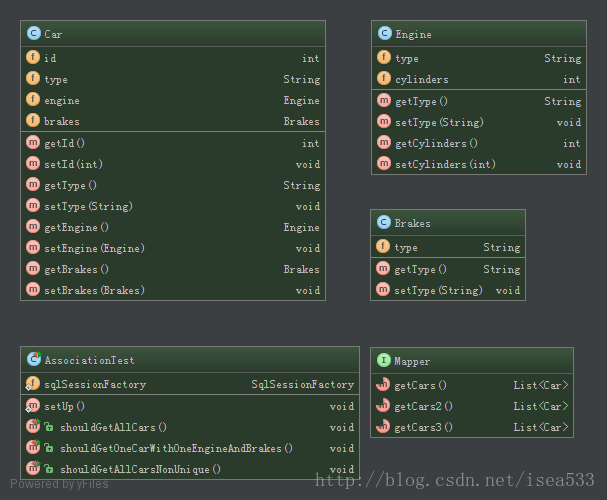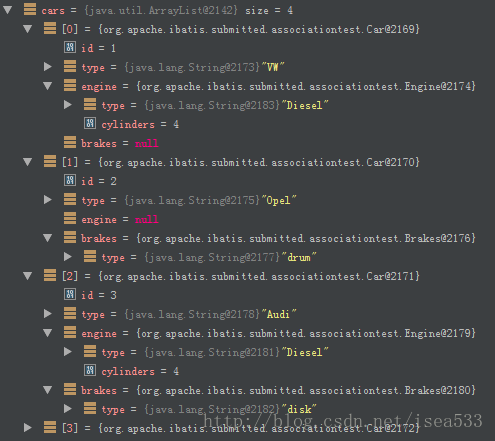接下來的文章中,關于Mybatis的示例,全部來自于Mybatis代碼中的單元測試代碼,通過這些代碼能夠學習Mybatis中很有用的知識,這些內容在doc文檔中可能只是簡單提到了,或者有一些文字說明,通過這些單元測試能更直觀的了解如何在Mybatis使用這些內容。
這一節內容為Association關聯的結果查詢,就是在查詢出結果后,根據查詢的列和resultMap定義的對應關系,來創建對象并寫入值。
- association – 一個復雜的類型關聯;許多結果將包成這種類型
- 嵌入結果映射 – 結果映射自身的關聯,或者參考一個
(注:“參考一個”,這里參考一個是通過對象的Key來唯一確定的,如果Key值一樣,就直接用已經存在的這個對象。)
association是resultMap中的一個配置選項,下面是用到的類的UML圖:

Car對象中包含了Engine和Brakes兩個對象。Mapper是接口對象。AssociationTest是該測試對象。
SQL表結構和數據:
|
1
2
3
4
5
6
7
8
9
10
11
12
|
drop table cars if exists; create table cars ( carid integer, cartype varchar(20), enginetype varchar(20), enginecylinders integer, brakestype varchar(20) ); insert into cars (carid, cartype, enginetype, enginecylinders, brakestype) values(1, 'VW', 'Diesel', 4, null); insert into cars (carid, cartype, enginetype, enginecylinders, brakestype) values(2, 'Opel', null, null, 'drum'); insert into cars (carid, cartype, enginetype, enginecylinders, brakestype) values(3, 'Audi', 'Diesel', 4, 'disk'); insert into cars (carid, cartype, enginetype, enginecylinders, brakestype) values(4, 'Ford', 'Gas', 8, 'drum'); |
Mapper.xml文件:
|
1
2
3
4
5
6
7
8
9
10
11
12
13
14
15
16
17
18
19
20
21
22
23
24
|
<mapper namespace="org.apache.ibatis.submitted.associationtest.Mapper"> <resultMap type="org.apache.ibatis.submitted.associationtest.Car" id="carResult"> <id column="carid" property="id"/> <result column="cartype" property="type"/> <association property="engine" resultMap="engineResult"/> <association property="brakes" resultMap="brakesResult"/> </resultMap> <resultMap type="org.apache.ibatis.submitted.associationtest.Engine" id="engineResult"> <result column="enginetype" property="type"/> <result column="enginecylinders" property="cylinders"/> </resultMap> <resultMap type="org.apache.ibatis.submitted.associationtest.Brakes" id="brakesResult"> <result column="brakesType" property="type"/> </resultMap> <select id="getCars" resultMap="carResult"> select * from cars </select> <select id="getCarsNonUnique" resultMap="carResult"> select 1 as carid, cartype, enginetype, enginecylinders, brakestype from cars </select> <select id="getCars2" resultMap="carResult"> select 1 as carid, cartype, enginetype, enginecylinders, brakestype from cars where carid in (1,2) </select> </mapper> |
其中的一個測試用例:
|
1
2
3
4
5
6
7
8
9
10
11
12
13
14
15
16
17
|
@Test public void shouldGetAllCars() { SqlSession sqlSession = sqlSessionFactory.openSession(); try { Mapper mapper = sqlSession.getMapper(Mapper.class); List<Car> cars = mapper.getCars(); Assert.assertEquals(4, cars.size()); Assert.assertEquals("VW", cars.get(0).getType()); Assert.assertNotNull(cars.get(0).getEngine()); Assert.assertNull(cars.get(0).getBrakes()); Assert.assertEquals("Opel", cars.get(1).getType()); Assert.assertNull(cars.get(1).getEngine()); Assert.assertNotNull(cars.get(1).getBrakes()); } finally { sqlSession.close(); } } |
cars返回值:

association是嵌套查詢中最簡單的一種情況,像上述例子中,一般我們都會用一個Car對面包含所有的屬性,這里的例子使用了嵌套對象,使對像的結構更鮮明。不過一般情況下很少會拆分一個對象為多個,用的多的時候是多表查詢的嵌套。
上面XML中的
carResult和engieResult,brakesResult都是分別定義,carResult引用了另外兩個resultMap。
對于不需要重用嵌套對象的情況,還可以直接這么寫,把上面的XML修改后:
|
1
2
3
4
5
6
7
8
9
|
<resultMap type="org.apache.ibatis.submitted.associationtest.Car" id="carResult"> <id column="carid" property="id"/> <result column="cartype" property="type"/> <association property="engine" javaType="org.apache.ibatis.submitted.associationtest.Engine"> <result column="enginetype" property="type"/> <result column="enginecylinders" property="cylinders"/> </association> <association property="brakes" resultMap="brakesResult"/> </resultMap> |
為了對比和區分,這里指修改了Engine,在association元素上增加了屬性javaType,元素內增加了result映射。
如果有association方面問題可以參考(或在此留言):
http://mybatis.github.io/mybatis-3/zh/sqlmap-xml.html
本節源碼請看官方Git:
以上所述是小編給大家介紹的Mybatis 入門示例代碼之 Association,希望對大家有所幫助,如果大家有任何疑問請給我留言,小編會及時回復大家的。在此也非常感謝大家對服務器之家網站的支持!
原文鏈接:http://blog.csdn.net/isea533/article/details/20868189















